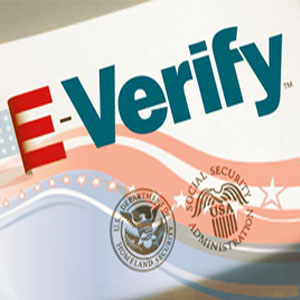E-Verify System: What must employers do?

Recently, many states have tried to discourage illegal immigration into their jurisdictions by enacting legislation focusing on enforcement. In May 2011, Arizona’s state-wide mandate on the use of E-Verify was upheld by the U.S. Supreme Court in Chamber of Commerce v. Whiting. As a result, many other states have since enacted legislation requiring at least partial adoption of E-Verify.
In the Southeastern United States, for example, Georgia, Florida, Alabama, North Carolina, South Carolina, Mississippi, Tennessee, and Louisiana, all mandate use of the E-Verify program (or, in the case of Tennessee, the use of an alternative program) for at least some employers. In Georgia, employers of 10 or more people are required to use E-Verify as of July 1, 2013. The majority of the states listed above require certain private employers to register with E-Verify and also to provide proof of such registration in order to get public contracts, pay certain business taxes, and renew most business licenses. The employer who fails to implement the E-Verify system properly may lose its ability to conduct business in that state.
E-Verify is a federal, online program through which employers (any business, nonprofit organization, or government agency) verify the employment eligibility of employees after hire. Employers submit information taken from a new hire’s Form I-9 (Employment Eligibility Verification Form) into the online E-Verify system. E-Verify then communicates the information to the Social Security Administration and U.S. Citizenship and Immigration Service (USCIS) to determine whether the information matches government records and whether the new hire is authorized to work in the United States.
Before you start using E-Verify, read the instructions on preparing your company’s procedures and equipment (www. uscis.gov/e-verify). Check that the company is not already enrolled. If not, enroll the company in the system by reading and completing the Memorandum of Understanding (MOU) for Employers. Then register yourself and any others to use the system.
Only then can the employer input data from the I-9s of employees hired on or after the date on which it signed and submitted the MOU. To do this, the employer must first have the paperwork complete. Each new hire or rehire must fill out the I-9 form within 3 business days that the employee starts to work. The employer must complete the employer’s section of the I-9 and review the form to see that it is completed correctly. The employer must then review the identification and employment eligibility documents, according to the list of acceptable documents, to verify the hire’s identity and eligibility for employment.
The employer then enters the new hire’s information into the online E-Verify system. If E-Verify does not give an immediate “Employment Authorized” response (e.g., there is a mismatch on the Social Security Number), then the paperwork and online entry should be reviewed for accuracy and the USCIS website should be consulted to determine how to proceed.
The employer should not re-verify existing employees’ employment authorization by requiring them to complete new I-9s without discussing this decision with its immigration counsel.
Employer’s self-audits. It is very common for I-9s to contain errors or omissions. Every employer should implement a self-audit of its I-9 system, involving an independent person who has experience with immigration compliance issues. This immigration expert comes on-site for a few days and reviews all I-9s and supporting documents for the employer. The attorney would identify and correct any errors, and then put a more accurate I-9 verification system in place for the future.
If the employer receives enough notifications of problems with the I-9 data that is being captured into the E-Verify system, then this means that the accuracy of the employer’s entire I-9 system should be called into question. A self-audit becomes a necessity at this point.
Self-audit should be repeated annually since E-Verify monitors company usage via Monitoring and Compliance (M&C) Assistance.
Failure to comply with I-9 verification and E-Verify requirements carries significant penalties. If USCIS determines that an employer has failed to use the E-Verify properly, then USCIS may deregister the employer from the system and block it from registering again in the future.

Business Insights is hosted by the Law Firm of Kumar, Prabhu, Patel & Banerjee, LLC.
Toni L. Castel is a Business Immigration Attorney and is of counsel to Kumar, Prabhu, Patel & Banerjee, LLC.
Disclaimer: This article is for general information purposes only, and does not constitute legal, tax, or other professional advice.
Enjoyed reading Khabar magazine? Subscribe to Khabar and get a full digital copy of this Indian-American community magazine.
blog comments powered by Disqus












